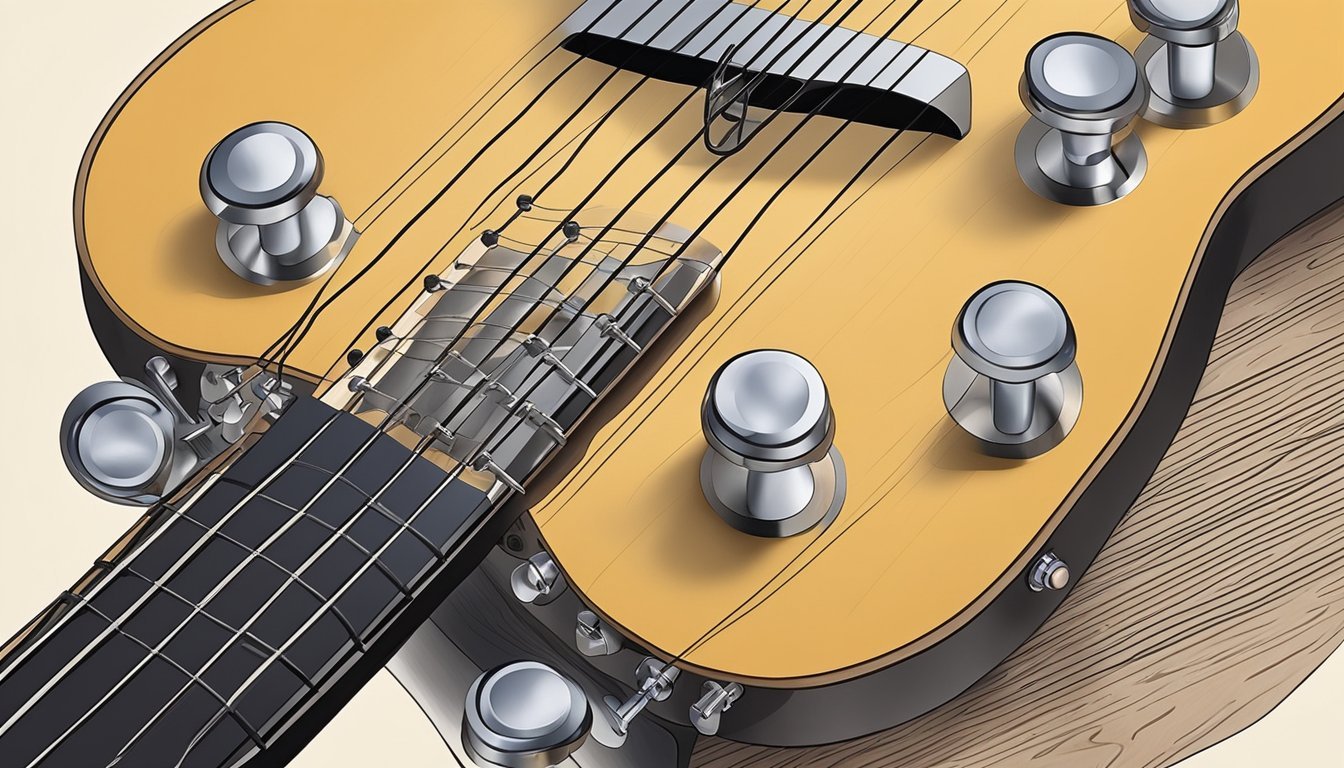Guitar strings play a crucial role in how your instrument sounds and feels.
Typically, they are made from various materials like steel, nickel, bronze, and nylon.
Each of these materials affects the tone and playability in unique ways.
If you’ve ever wondered why some strings sound brighter or warmer than others, understanding their composition will shed light on this mystery.

Over the years, guitar string materials have evolved to enhance performance and durability.
From the classic gut strings of the past to modern metal and synthetic options, you’ll find a wide range of choices suited for different styles and genres.
Knowing what is inside those strings can help you make better decisions when it comes to your playing preferences and maintenance.
So, whether you’re a beginner looking to buy your first set of strings or a seasoned player curious about the latest materials, this guide will give you valuable insights into what makes guitar strings tick.
Get ready to explore how different materials can change your guitar’s sound and improve your playing experience.
Key Takeaways
- Guitar strings are made from various materials that impact sound and tone.
- Understanding string types helps you choose the right ones for your style.
- Maintenance can extend the life of your guitar strings and enhance performance.
History and Evolution of Guitar String Materials
Guitar strings have changed a lot over time, evolving from animal materials to modern metal and synthetic options.
This journey reflects advances in technology and user preferences, impacting how you experience sound and playability.
From Gut to Nylon and Steel
Traditionally, guitar strings were made from gut, specifically sheep intestines.
These gut strings offered a warm, rich tone that many musicians loved.
In the late 19th century, steel strings began to appear.
They were louder and more durable than gut strings, resulting in a shift in design and playing style.
Steel strings often consist of high-carbon steel with various winding materials, including nickel and phosphor bronze for tonal brightness.
Nylon strings emerged for classical and flamenco guitars.
They provide a softer touch and warmer sound compared to steel.
Technological Advancements
With time, innovations in material science improved guitar strings.
Today, strings can have coatings that enhance durability and protect against corrosion.
Brands like Elixir Strings offer a protected coating to keep your strings sounding fresh longer.
Modern strings often feature blends like 80/20 bronze or pure nickel for different tonal qualities.
These materials play a crucial role in achieving the sound you want.
Different string types allow you to customize your playing.
Whether you prefer the brightness of steel strings or the mellow tone of nylon, advancements in materials have made it easier than ever to find what suits your style.
Understanding Guitar Strings Types and Builds

Guitar strings come in various types and materials, each designed for different guitars and playing styles.
It’s essential to know what makes them unique and how different factors like construction and gauge impact your sound and playability.
Acoustic Versus Electric
When it comes to acoustic and electric guitars, the strings differ significantly. Acoustic guitar strings often have a steel core wrapped in materials like bronze or phosphor bronze.
This combination gives them a bright and resonant tone, perfect for folk, country, or rock music.
Electric guitar strings, on the other hand, usually have a nickel or stainless steel winding over a steel core.
This construction helps produce a sharper sound that cuts through the mix in genres like rock, blues, and metal.
In general, acoustic strings aim for a warm, natural tone, while electric strings focus on sustain and clarity.
If you’re switching between guitars, knowing these differences can help you choose the right sound for your music.
Deciphering String Gauges
String gauge refers to the thickness of the strings, which comes in a range of measurements.
Most guitarists select gauges that balance playability and tone.
Common electric guitar gauges include:
- Light: .009 – .042
- Medium: .010 – .046
- Heavy: .011 – .054
For acoustic guitars, you’ll often see:
- Light: .011 – .052
- Medium: .012 – .054
Thicker strings (heavier gauges) offer more volume and sustain but may require more finger strength to play.
Conversely, lighter strings are easier to play but can produce a thinner sound.
Your choice in gauge ultimately depends on your playing style and comfort level.
Material Science: Alloys and Coatings

When it comes to guitar strings, the materials play a big role in how they sound and perform.
The types of alloys used and whether the strings have coatings can really impact their durability, tone, and longevity.
Alloys Used in Strings
Guitar strings are primarily made from various alloys that mix metals to create specific sounds and characteristics.
Here are some common types: These alloys can include combinations of nickel, stainless steel, and bronze, each contributing to the overall tone and playability of the strings.
When exploring guitar string types and their effects, musicians often notice significant differences in brightness, warmth, and sustain, depending on the materials used.
Additionally, the gauge or thickness of the strings also plays a crucial role in their responsiveness and the ease of bending notes.
- Nickel Strings: These are popular for their warm tone and smooth feel. They’re great for electric guitars.
- Nickel-Plated Steel Strings: A mix of nickel and steel, these offer a bright tone while maintaining some warmth.
- Stainless Steel Strings: Known for their brightness and resistance to corrosion, these strings are ideal for those who play frequently.
- Bronze and Phosphor Bronze Strings: These are often used for acoustic guitars. Bronze has a bright sound, while phosphor bronze adds warmth and resonance.
Each alloy brings something unique to your playing experience, affecting the sound and feel of your instrument.
The Role of Coatings
Coatings on guitar strings can enhance durability and playability.
You might encounter these coated options:
- Coated Strings: These have a protective layer that helps prevent dirt and sweat damage, extending their life.
- Cobalt Strings: Made with a cobalt alloy, they deliver clarity and a strong tone, while the coating provides additional durability.
Coatings can also impact the feel of the string, making them smoother under your fingers.
They help maintain tone quality longer, ensuring your guitar sounds great even after multiple sessions.
If you’re looking for enhanced longevity without sacrificing sound, coated or cobalt strings might be the way to go.
Maintenance and Longevity of Strings

Taking care of your guitar strings can make a big difference in how long they last and how good they sound.
By preventing rust and dirt build-up, you can keep your strings in great shape, allowing for better playability and tonal quality.
Here’s how you can maintain your strings effectively.
Preventing and Treating Corrosion
Corrosion is a major enemy of guitar strings.
It can happen due to sweat, oil, and dirt getting on the strings.
To keep rust at bay, wipe your strings with a clean, dry cloth after each session.
You can also use string cleaners designed specifically for guitars.
Tip: For extra protection, consider using coated strings.
These have a special finish that helps resist dirt and oxidation, extending their lifespan.
If you notice any signs of corrosion, like rust spots or discoloration, it’s a good idea to replace the strings.
This helps maintain your instrument’s sound quality and keeps playing enjoyable.
Maximizing Playability and Tone
Your playing style can affect how quickly strings wear out.
If you play often and with a lot of force, your strings might lose their tonal quality faster.
To maximize playability, consider the type of strings you use.
Nickel-plated strings offer great durability and tonal flexibility.
On the other hand, pure nickel strings give a warmer sound but may wear out more quickly with aggressive playing.
Be mindful that dirt and oil can build up on the strings, leading to a dull sound.
Regular cleaning is key.
You might also want to rotate your strings periodically, especially if you play daily.
String Replacement and Care Tips
Knowing when to change your strings is essential for maintaining sound quality.
If your strings start sounding dead or dull, it’s time for a change.
A general rule of thumb is to replace them every 1-2 weeks if you play frequently.
For string care, always store your guitar in a cool, dry place.
Humidity can accelerate rust and oxidation.
You might also want to keep your hands clean and dry when playing to minimize oil transfer.
Quick care tips:
- Wipe strings after each use.
- Use coated strings for added longevity.
- Change strings regularly based on your playing style.
These simple practices will keep your guitar strings lasting longer and sounding great.
Frequently Asked Questions
You might have some questions about guitar strings and their differences.
This section breaks down some common inquiries to help you understand what makes each type of string unique.
Are acoustic guitar strings different from electric guitar strings?
Yes, they are different.
Acoustic guitar strings are typically made of bronze or brass wire, which produces a bright, resonant tone when played.
Electric guitar strings, on the other hand, are usually made of nickel or steel to enhance magnetic pickup sensitivity.
Why are some guitar strings made from nylon?
Nylon strings are commonly used for classical guitars.
They offer a softer touch and a warmer tone, making them easier on the fingers, especially for beginners.
They also produce a mellow sound that’s perfect for classical styles.
Can you tell the difference between bronze and steel strings by playing?
Yes, you can.
Bronze strings have a brighter and more ringing sound.
Steel strings give a sharper tone with more projection.
The difference may be subtle, especially for beginners, but experienced players often notice it.
What materials are typically used for bass guitar strings?
Bass guitar strings are often made from nickel or stainless steel.
These materials provide strength and durability, allowing the strings to produce rich, deep tones necessary for bass lines.
Some newer options even include flatwound strings for a smoother sound.
Why do classical guitarists prefer certain types of strings?
Classical guitarists usually prefer nylon or composite strings for their instrument.
These strings produce a warmer, softer sound that complements classical music styles.
Some players may choose different gauges for varied tonal qualities and playability.
What’s the deal with catgut guitar strings?
Catgut strings are made from the intestines of sheep or goats, not cats.
Historically, people used them before synthetic materials became popular.
They offer a unique tone, but they are less common today due to their cost and maintenance needs.

